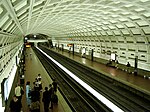Dupont Circle

Dupont Circle (or DuPont Circle) is a historic roundabout park and neighborhood of Washington, D.C., located in Northwest D.C. The Dupont Circle neighborhood is bounded approximately by 16th Street NW to the east, 22nd Street NW to the west, M Street NW to the south, and Florida Avenue NW to the north. Much of the neighborhood is listed on the National Register of Historic Places. However, the local government Advisory Neighborhood Commission (ANC 2B) and the Dupont Circle Historic District have slightly different boundaries.The traffic circle is located at the intersection of Massachusetts Avenue NW, Connecticut Avenue NW, New Hampshire Avenue NW, P Street NW, and 19th Street NW. The circle is named for Rear Admiral Samuel Francis Du Pont. The traffic circle contains the Dupont Circle Fountain in its center. The neighborhood is known for its high concentration of embassies (many along Embassy Row) and think tanks (many along Think Tank Row).
Excerpt from the Wikipedia article Dupont Circle (License: CC BY-SA 3.0, Authors, Images).Dupont Circle
Connecticut Avenue Northwest, Washington Dupont Circle
Geographical coordinates (GPS) Address Nearby Places Show on map
Geographical coordinates (GPS)
| Latitude | Longitude |
|---|---|
| N 38.909638888889 ° | E -77.043444444444 ° |
Address
Dupont Circle Fountain
Connecticut Avenue Northwest
20036 Washington, Dupont Circle
District of Columbia, United States
Open on Google Maps








